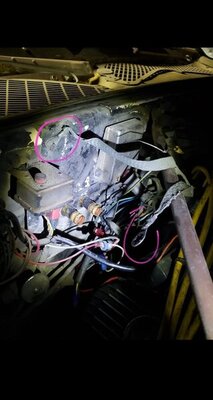451Mopar
Well-Known Member
I'm back. Thanks for all the input. Sorry about the delay, work had me up till the wee hrs of the night. Here are the results to my tests using a multimeter:
At the battery + to -
Engine off: 12.2v
Key to "on" position: 11.2
Engine on: 11.2v
w/ parking lights on: 11.64v
w/ full lights on: 11.49
After turning engine back off: 12.01v
Voltage drop tests
Engine on and revved to about 1000-1300rpm
From negative battery lead to:
Alternator case: 2.1v
Alternator bracket: 2.2v
Engine block: 1.3v
Chassis ground point: in the mv range
From the positive battery lead to the alternator lead: .33v
From the looks of thing it seems like my alternator is shot? Had no idea it was this bad since the battery hasn't been straining on start ups.
If your droping 2.1 to 2.2 volts from battery ground to the alternator case ground, then there is really bad connections of the alternator to battery.


















